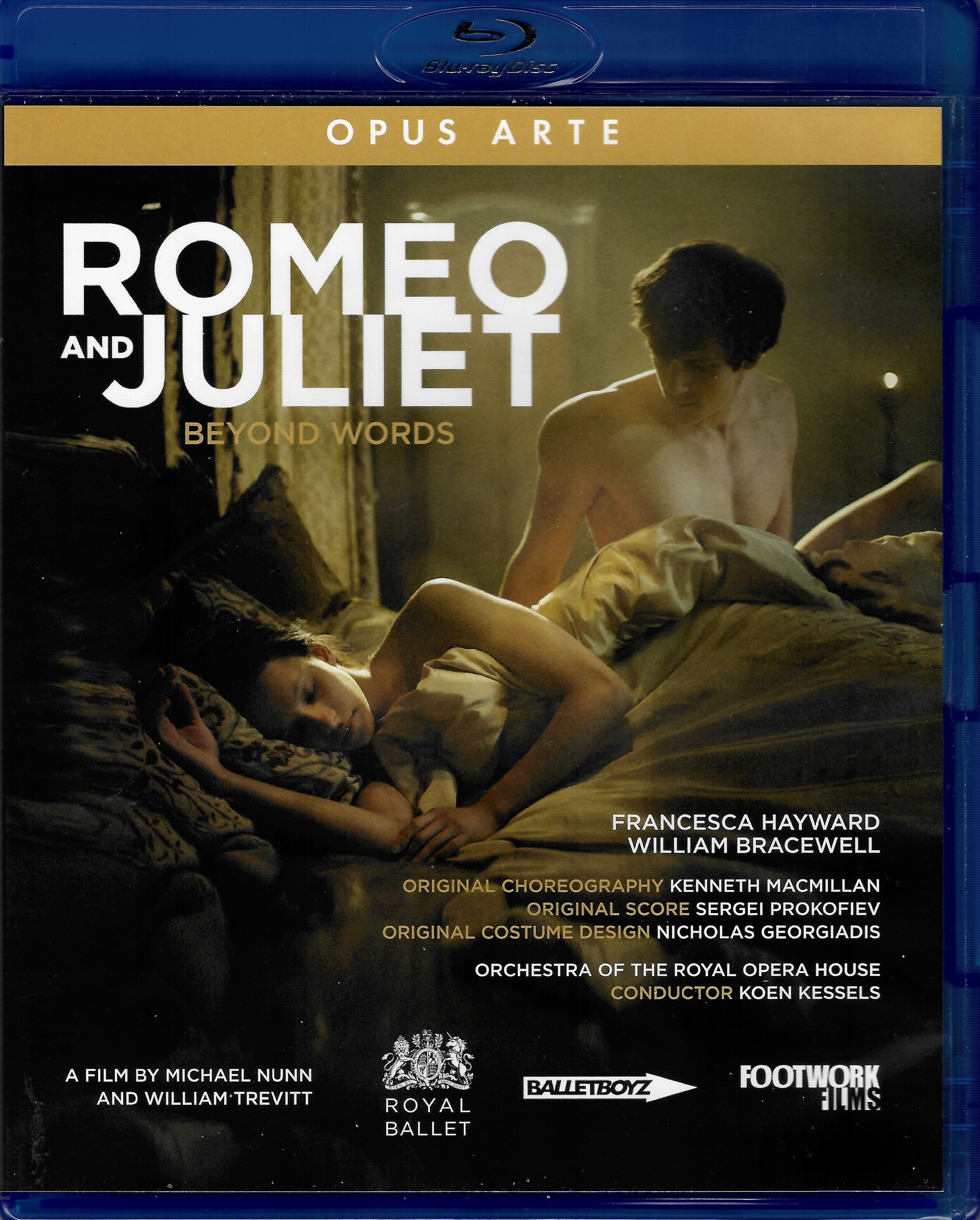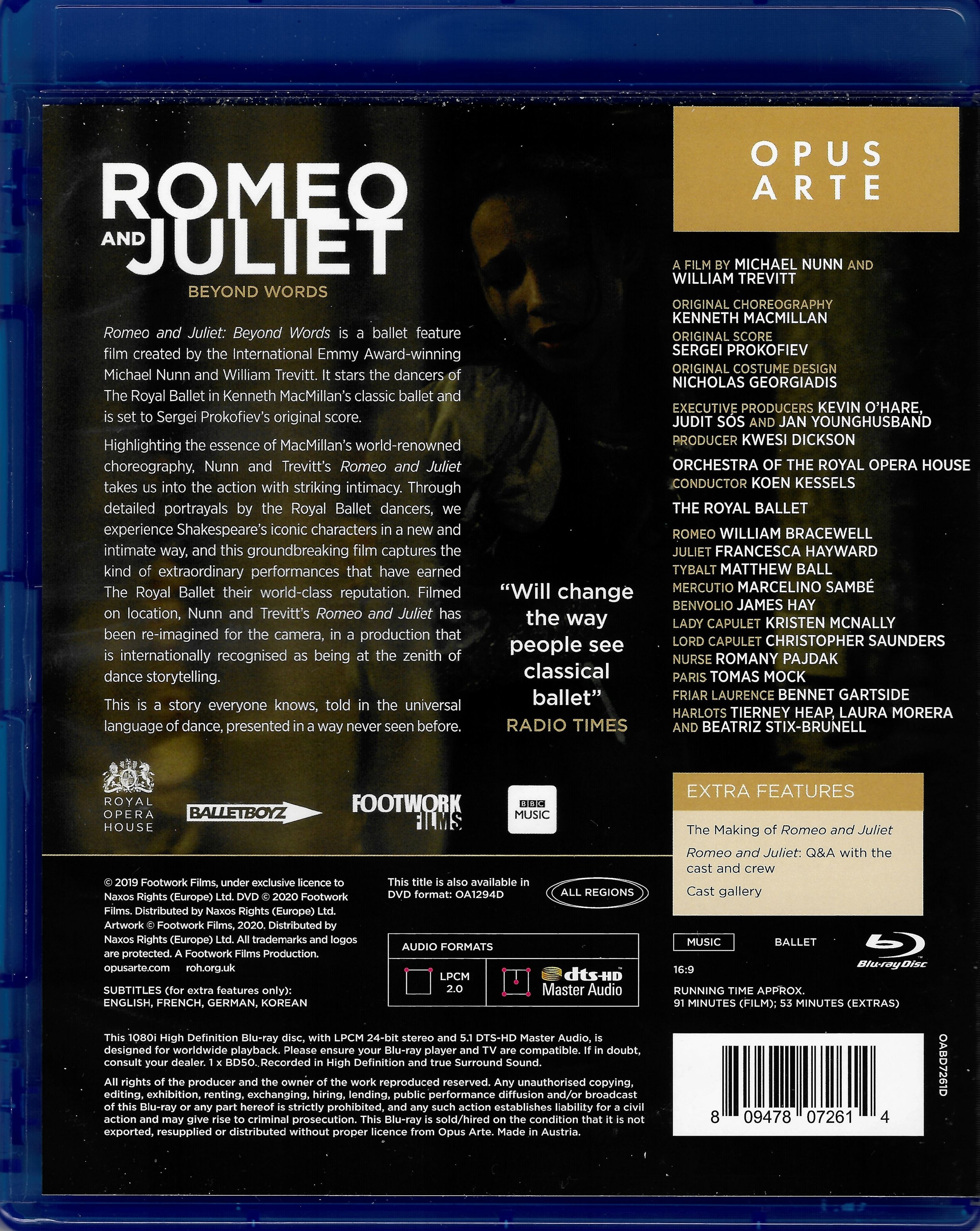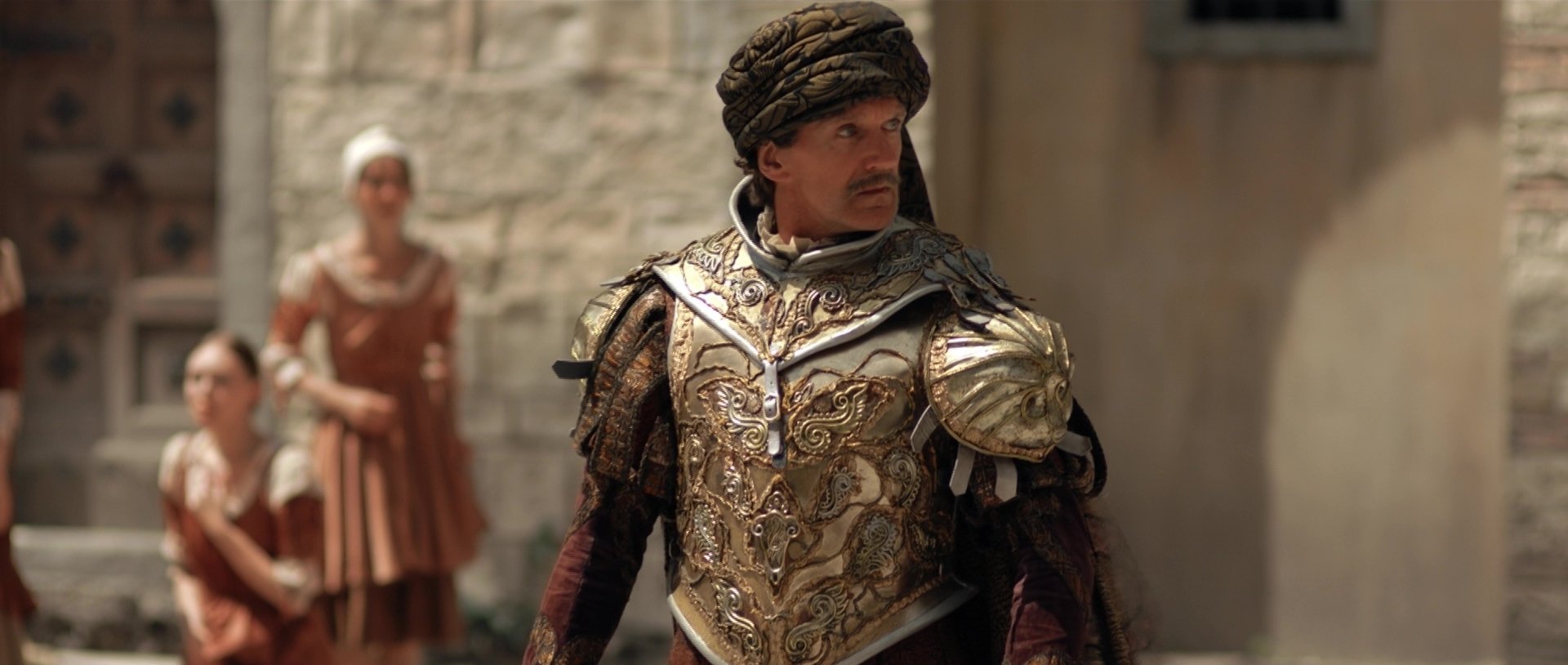

Romeo and Juliet - Beyond Words. Music by Prokofiev and choreography by Kenneth MacMillan in motion picture format. The action was directed by Michael Nunn and the film was directed by William Trevitt in 2019. Nunn and Trevitt are ballet dancers and choreographers who started their careers with the Royal Opera Ballet and have worked on many projects together. The film was shot on stages built in Hungary originally for a made-for-TV drama set in Renaissance Italy. Stars William Bracewell (Romeo), Francesca Hayward (Juliet), Matthew Ball (Tybalt), Marcelino Sambé (Mercutio), James Hay (Benvolio), Kirsten McNally (Lady Capulet), Christopher Saunders (Lord Capulet), Romany Pajdak (Nurse), Tomas Mock (Paris), Bennet Gartside (Friar Laurence), Tierney Heap, Laura Morera, and Beatriz Stix-Brunell (Harlots), as well as many other dancers of the Royal Ballet. The full Romeo and Juliet ballet runs about 158 minutes; this film version runs 91 minutes. Koen Kessels conducts the Orchestra of the Royal Opera House (Concert Master Vasko Vassilev) in a special arrangement of the Prokofiev music that matches the action in the finished film. Costume design by Nicholas Georgiadis. Executive Producers were Kevin O’Hare, Judit Sós, and Jan Younghusband. The Producer was Kwesi Dickson. Released 2020, disc has 5.1 dts-HD Master Audio sound. Grade: B with the ‽ designation.
Since 2008, the Royal Opera/Ballet and its subsidiary, Opus Arte, have been leaders in packaging opera and ballet works in top-quality Blu-ray titles. Here it appears the Royal Ballet and the BBC are trying to create a new motion picture genre: a 90 minute cut-down version of a classic ballet work with naturalistic movie-quality production values aimed mostly at audiences on TV and in movie theaters. It appears this show was shown multiple times on TV in Europe beginning during the Covid-19 pandemic. It will doubtless be back on TV and in movie houses in the future. And now we can have it in our beloved Blu-ray disc format. H’m . . . do you think this might work? Let’s take a look!
Our first shot below is the main square in old Verona. There are two warring big clans: the Montagues, who usually dress in brown and the Capulets, who usually dress in red. The Montagues are upstarts—they are more earthly and closer to the townspeople than the snooty Capulets. The Montagues have one son, Romeo. Romeo’s close friend Benvolio (James Hay) is seen below biting an apple. With Benvolio is Mercutio (Marcelino Sambé). Mercutio is not a member of either of the warring clans. He is related to the Duke, but he loves the Montagues because they are so much fun:
Now seen the middle below is Romeo (William Bracewell) joking with Benvolio and Mercutio. Why are the Montagues so much fun? Well, girls and sword fighting is all they think about:
The most interesting girls are the 3 harlots (entirely an invention of MacMillan). From left to right they Beatrix Stix-Brunell, Laura Morera, and Tierney Heap:
I think of Morera as the head harlot, who has a special thing going with Romeo:
Next below we meet Lord Capulet (Christopher Saunders) in the middle. He has no son—only a daughter named Juliette. To Capulet’s left is his nephew, Tybalt (Matthew Ball). Tybalt is commander of the Capulet knights. The Capulets fear they may be overpowered by the Montagues. So the top priority for Lord Capulet is to gain an ally through the marriage of Juliette to Paris (Thomas Mock), the son of another powerful clan:
Tybalt is no fun at all. He’s a brooding, take-charge type:
A huge fight breaks out in the square between the Capulet and Montague men. Prince Escalus (Gary Avis) himself arrives to stop the riot:
Arms control. The Prince makes everybody promise to do better. In the foreground are some of the Capulets. In the background are some of the Montagues in brown and green. Lady Montague (Siam Murphy) bows to her counterpart:
Now the Capulets see it as existential for Juliette (Francesca Hayward) to marry into a strong family with many knights. The nurse (Romany Pajdak) must explain to Juliette why she needs to stop playing with a doll baby and become the mother of a real baby:
But Juliette doesn’t quite get it yet. She is too shy to even look up when Paris is introduced to her as her future husband:
But the arrangements have been made. The Capulets throw a big party celebrating the expected marriage. In the Dance of the Knights below, Capulet is flanked by his nephew Tybalt on his left and soon-to-be-son-in-law Paris on his right. Soon they will both be dead:
You probably know that Romeo and his friends crash the party. Juliette sees Romeo for the first time. She knows who is. She knows how wrong and dangerous her feelings are. But one can’t control love at first sight:
The party quickly gets out of control. They say you can’t hide a cough or love:
The party-crashers flee the scene, but Romeo doubles back to find Juliet:
The craziness escalates. Friar Lawrence (Bennet Gartside) agrees to marry R&J in secret hoping that the union will quell the friction between the clans:
Soon thereafter Tybalt and Mercutio tangle in the streets (neither knows of the secret wedding):
Romeo tries to stop the fight, but he distracts Mercutio who then gets run through by Tybalt. Knowing he will die, Mercutio curses the clans by calling for a plague on both their houses. The curse will soon be fulfilled:
Enraged, Romeo attacks and kills Tybalt (now his wife’s closest cousin). Below see the grief of Lady Capulet (Kirsten McNally ) who loved Tybalt as the son she never had. A thunderstorm breaks out and everybody wallows in mud. (They had to get this in one take!)
Romeo was immediately exiled from Verona on pain of death. But he sneaks into his wife’s bedroom for a honeymoon of one night:
Shortly after Romeo departs, Juliette receives her parents who demand that she immediately marry Paris. The are astounded at Juliet’s behavior. But eventually, Juliet buys time by pretending to accept Paris:
Ballet dancers get acting training. They learn how to use exaggerated facial expression and body movements to communicate with everyone in a giant auditorium. This is the opposite of how movie actors work, who must use exquisitely subtle expressions in voice, face and body movements to tell their stories. Since no one speaks in this movie, the acting challenge for the dancers is immense. The dancers do a much better job of acting than actors would do as dancers! And in the image below, Hayward is fabulous in projecting Juliet’s anguish and resolve to be true to Romeo:
Juliet takes the potion that will make her appear to be dead for some hours. By custom, she will be laid out in the family tomb. Romeo will come, wake her, and take her also into exile:
In the ballet, Juliet’s girlfriends come early in the morning to help her get ready for her marriage. In the movie you see this touching scene from a completely new perspective:
In the stage ballet, the view of (deep sleeping) Juliet on her tomb is shown in an impressive and touching way. It seems Nunn and Trevitt wanted to do something different and more naturalistic. So they shot the end of the story (with the deaths of Paris, Romeo, and Juliet) through bars and in low light. There are many other segments in the film shot deliberately from behind barriers or through thin fabric. I think these special effects work against the film when seen on a TV display. Maybe this would be impressive in a state-of-the-art movie house. But this film was probably not going to run in the best movie houses:
So what do we make of this unusual, bold, and expensive effort to create a new genre of fine-art motion pictures?
Well, at best it’s Romeo and Juliet Lite. This show (like the stage ballet) completely misses the point that this is not a story about young love. Shakespeare tells a story about the redemptive power of love which, through tragic sacrifice, causes two warring clans to finally make peace (and thereby make Verona a safe place for all it’s citizens). Why not respect the Bard’s Epilogue and have a final scene where the elders are on their knees together raising statutes of gold to honor their dead children? That would have made this movie something special.
There is little sense of scale. The sets rented in Hungary make Verona look like a farmhouse or village with one dinky, dry fountain. The plot is compressed from 180 minutes for the play to 135 minutes for the stage ballet, to 90 (TV) minutes here. The result is a kind of Cliff Notes Film. Even thought I know the play pretty well and have seen the Royal Ballet show multiple times in my home theater, I had trouble following who the various characters were! The blazing pace of the film leaves no time to figure things out. I also found myself irritated that many auteur-like shots were made with interference from barriers, bars, gauze-like fabrics, and low light. I didn’t like the thunderstorm that turned the death of Tybalt and the grief of Lady Capulet into a pig wallow. Shakespeare, Prokofiev, and MacMillian do not need embellishment by another genius.
The film has tech issues. The night scenes were quite dark. I noticed considerable motion blur, and the focus of the cameras did not always seem as sharp as I’m used to.
But there were also good things. I loved seeing the dancers from many different points of view. I was astonished how quickly I got used to seeing five-position classical ballet steps executed in the “natural” setting together with children and animals running around. I was surprised how well the dancers could act. I guess you really could do a great naturalistic Shakespeare play in dance without words if you could afford impressive real locations and had plenty of time to study rushes and reshoot when needed. I loved the music more than ever before! I think the score got chopped up and rearranged a lot to get to 90 minuets. It was all familiar, but somehow sounded new. And I was thrilled to see my that favorite dancer, Laura Morera, could still do the harlot.
In February 2022 I checked Rotten Tomatoes. They have a story up for this show as a movie. But this film was released during the Covid-19 pandemic and only one person had made a comment. This is not encouraging, but it’s probably too soon to reach a conclusion. The only review I found from a well-known print critic was a long and thoughtful piece from Rob Maynard writing for musicweb-international.com. Rob concludes R&J Beyond Words is aimed at ballet tyros and not at ballet lovers. For the beginners, Rob gives enthusiastic approval.
Our own Wonk Zachary Farr saw this on TV. Here’s his assessment:
“I love the idea of doing something like this where you are taking advantage of camera movement and editing. However I thought this particular production left something to be desired. My biggest complaint is that this was shot in widescreen aspect ratio . Since humans are much taller than wide, this means the dancers appear quite small on the screen. I thought it is also edited much too fast with many shots not showing the full bodies of the dancers. Still, I might buy a Blu-ray of this just to show my support for someone with new ideas.”
I did not run a Wonk Ballet Worksheet on this title because we don’t apply our phobias about DVDitis to motion pictures or motion-picture-like videos.
I’ll give this a B -. It also gets the ‽ alert because I agree with Maynard that it’s best suited for dance newbies (or maybe for high-school students who are terrified of trying to read the Romeo and Juliet play). Maybe it points a way forward for other dance film projects if the producers can raise the money to shoot in truly natural locations.
Here’s a trailer from Footwork Films for the TV showing:
OR


























